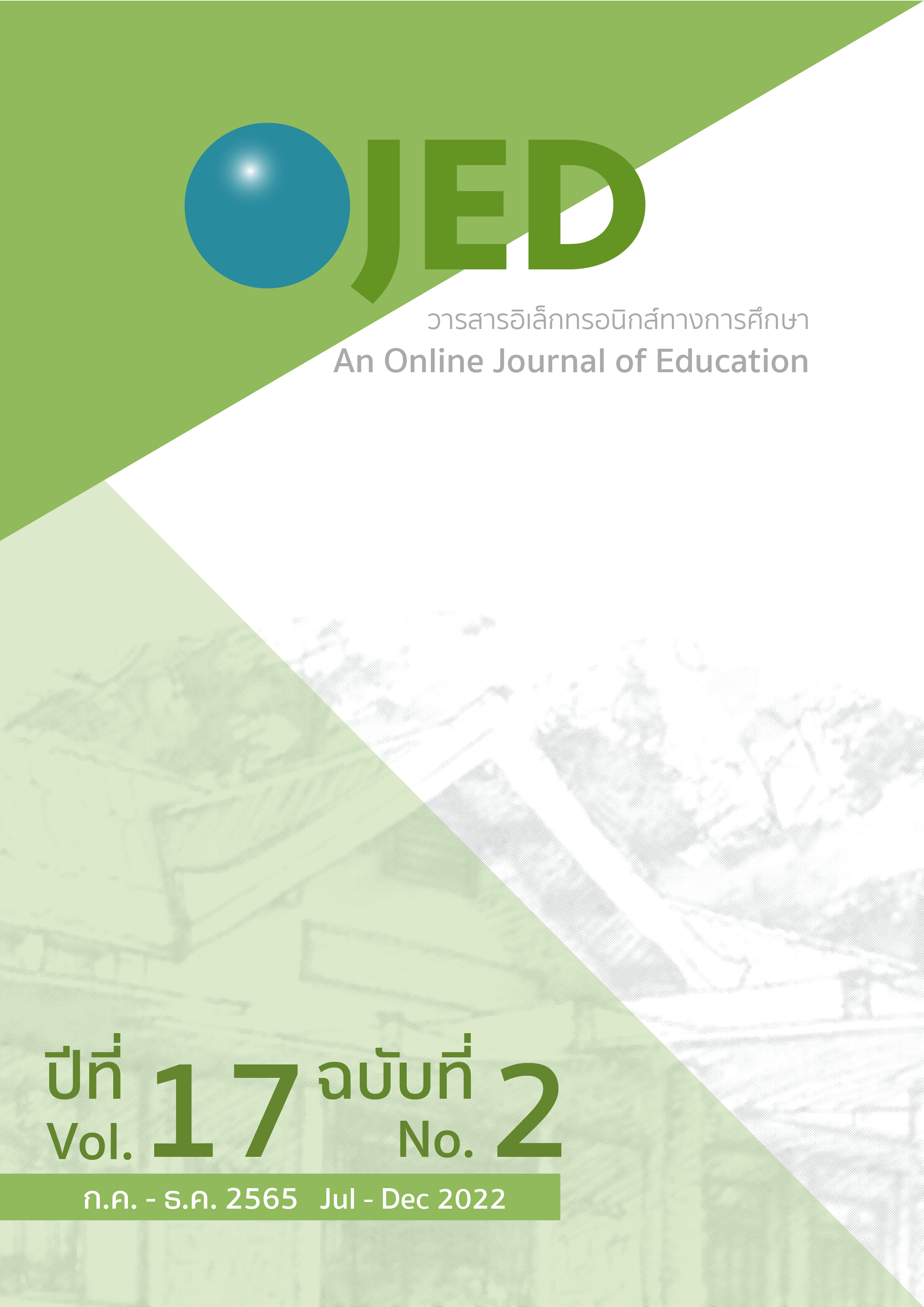Enhancing Productive Vocabulary Knowledge of Form-Meaning and Collocation of Secondary School Students Through Vocabulary Instruction Using Captioned Audiovisual Materials
DOI:
https://doi.org/10.14456/ojed.2022.42Keywords:
vocabulary instruction, productive vocabulary knowledge, captions, audiovisual materialsAbstract
This study probed into the effects of vocabulary instruction using captioned audiovisual materials on productive vocabulary knowledge regarding form-meaning link and collocation of secondary students. In addition, the study explored students' opinions toward the vocabulary instruction using English captioned audio-visual materials. Twenty grade ninth students took part in this study. During the seven-week instruction, the class followed a three-stage process of vocabulary instruction adapted from Nation (2013), namely Noticing, Retrieval, and Creative Use, using English captioned videos as the input for learning form-meaning, and collocation. This study employed two research instruments: the pre and post productive vocabulary knowledge tests and the opinion questionnaire which aimed to gather students’ opinions towards the vocabulary instruction and the captioned audiovisual materials. The results revealed that students' productive vocabulary knowledge of form-meaning connection and collocation significantly improved. Students also reported positive opinions toward vocabulary instruction and the captioned videos. The findings suggest that the use of English captioned videos in the vocabulary instruction is effective for students’ development of productive vocabulary knowledge of form-meaning and collocation; however, materials should be carefully selected along with pedagogical instruction.
References
Bensalem, E. (2016). Effects of captioning video clips on vocabulary learning among ESL learners. International Journal of Humanities and Cultural Studies, 3(2), 381-395.
Carlisle, J, F., Fleming, J, E., & Gudbrandsen, B. (2000). Incidental word learning in science classes. Contemporary Educational Psychology, 25(2), 184-211. https://doi.org/10.1006/ceps.1998.1001
Danan, M. (2004). Captioning and subtitling: Undervalued language learning strategies. Meta, 49(1), 67-77. https://doi.org/10.7202/009021ar
Faqe, C. (2017). The effectiveness of English movie subtitles in vocabulary learning among Iraqi Kurdistan EFL learners: Soran university EFL learners as an example. International Journal of Current Advanced Research, 6(3), 2590-2594. https://doi.org/10.24327/ijcar.2017.2594.0053
Faraj, A. K. A. (2015). Effective strategies for turning receptive vocabulary into productive vocabulary in EFL context. Journal of Education and Practice, 6(27), 10-19.
Feng, Y. (2017). How does mode of input affect incidential vocabulary learning [Master’s thesis]. Western University.
Hill, M. & Laufer, B. (2003). Type of task, time-on-task and electronic dictionaries in incidental vocabulary acquisition. International Review of Applied Linguistics in Language Teaching, 41, 87-106. https://doi.org/10.1515/iral.2003.007
Hsu, H. (2018). Incidental professional vocabulary acquisition of EFL business learners: Effect of captioned video with glosses. JALT CALL Journal, 14(2), p119-142.
Hsu, W. (2014). The effects of audiovisual support on EFL learners’ productive vocabulary. ReCALL, 26(1), 62-79. https://doi.org/10.1017/S0958344013000220
Hulstijn, J. H. (2001). Intentional and incidental second language vocabulary learning: A reappraisal of elaboration, rehearsal and automaticity. In P. Robinson (Ed.), Cognition and second language instruction (pp. 258–286). Cambridge University Press.
Koskinen, P. S., Wilson, R, M., Gambrell, L, B., & Neuman, S, B. (1993). Captioned video and vocabulary learning: An innovative practice in literacy instruction. The Reading Teacher, 47(1), 36-43.
Laufer, B. & Nation, I. S. P. (1999). A vocabulary-size test of controlled productive ability. Language testing, 16(1), 33-51. https://doi.org/10.1177/026553229901600103
Laufer, B., & Goldstein, Z. (2004). Testing vocabulary knowledge: Size, strength and computer adaptiveness. Language Learning, 54(3), 399-436. https://doi.org/10.1111/j.0023-8333.2004.00260.x
Lee, E.-H., & Park, M.-R. (2017). The effects of subtitled movies on learners’ affective domain and productive vocabulary knowledge. STEM Journal, 18(4). https://doi.org/10.16875/stem.2017.18.4.37
Ma, S., Zhang, J., Anderson, R. C., Morris, J., Nguyen-Jahiel, K. T., Miller, B., Jadallah, M., Sun, J., Lin, T., Scott, T., Hsu, Y., Zhang, X., Latawiec, B., & Grabow, K. (2017). Children's productive use of academic vocabulary, Discourse Processes, 54(1), 40-61. https://doi.org/10.1080/0163853X.2016.1166889
McCarthy, M., & O'Dell, F. (2005). English collocations in use. Cambridge University Press.
Nation, I. S. P. (1990). Teaching and Learning Vocabulary. Rowley, Newbury House.
Nation, I. S. P. (2012). The BNC/COCA word families list. http://www.victoria.ac.nz/lals/staff/paul-nation
Nation, I. S. P. (2013). Learning vocabulary in another language (2nd ed.). Cambridge University Press.
Newton, J. (2013). Incidental vocabulary learning in classroom communication tasks. Language Teaching Research, 17(3), 164-187. https://doi.org/10.1177/1362168812460814
Pattermore, A., & Munoz, C. (2020). Learning L2 constructions from captioned audio-visual exposure: The effect of learner-related factors. System, 93(4). https://doi.org/10.1016/j.system.2020.102303
Peters, E., & Webb, S. (2018). Incidental vocabulary acquisition through viewing L2 television and factors that affect learning. Studies in Second Language Acquisition, 40(3), 551-577. https://doi.org/10.1017/S0272263117000407
Schmidt, R. (1990). The role of consciousness in second language learning. Applied Linguistics, 11, 129-158
Schmitt, N. (2010). Researching vocabulary: A vocabulary research manual. Palgrave Macmillan.
Sydorenko, T. (2010). Modality of input and vocabulary acquisition. Language Learning & Technology, 14(2), 50-73.
Tahmasbi, M., & Farvardin, M. T. (2017). Probing the effects of task types on EFL learners’ receptive and productive vocabulary knowledge: The case of Involvement Load Hypothesis. SAGE Open, 1-10. https://doi.org/10.1177/2158244017730596
Teng, F. (2019). The effects of video caption types and advance organizers on incidental L2 collocation learning. Computers & Education, 142. https://doi.org/10.1016/j.compedu.2019.103655
Teng, F. (2020). Vocabulary learning through videos: Captions, advance-organizer strategy, and their combination. Computer Assisted Language Learning, 35(3), 518-550 https://doi.org/10.1080/09588221.2020.1720253
Webb, S. (2005). Receptive and productive vocabulary learning: The effects of reading and writing on word knowledge. SSLA, 27, 33-52. http://doi.org/10.1017/S0272263105050023
Webb, S. (2007). The Effects of Repetition on Vocabulary Knowledge. Applied Linguistics, 28, 46-65. http://doi.org/10.1093/applin/aml048
Webb, S. (2013). Depth of vocabulary knowledge. In C. A. Chapelle (Ed.), The Encyclopedia of Applied Linguistics (pp.1656-1663). Blackwell. https://doi.org/10.1002/9781405198431.wbeal1325
Webb, S., & Kagimoto, E. (2009). The effects of vocabulary learning on collocation and meaning. Tesol Quarterly, 43(1), 55-77.
Wray, A. (2002). Formulaic language and the lexicon. Cambridge University Press.
Zhang, X. (2017). Effects of receptive-productive integration tasks and prior knowledge of component words on L2 collocation development. System, 66, 156-167. https://doi.org/10.1016/j.system.2017.03.019
Downloads
Published
How to Cite
Issue
Section
License
Copyright (c) 2022 An Online Journal of Education

This work is licensed under a Creative Commons Attribution-NonCommercial-NoDerivatives 4.0 International License.




